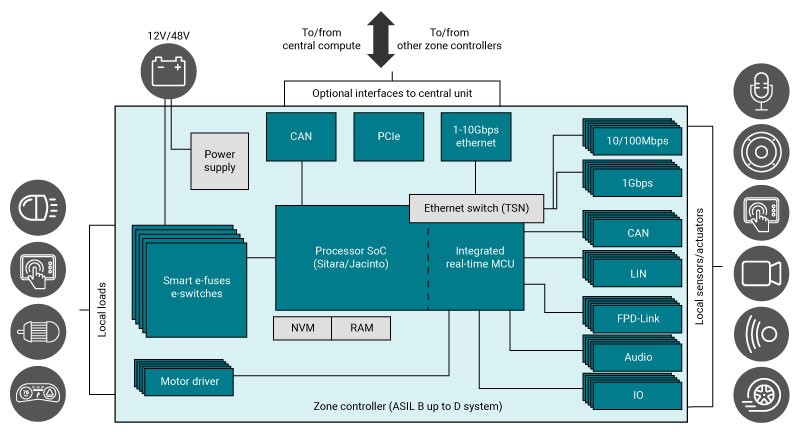SPRY345B february 2022 – april 2023 DP83TG720R-Q1 , DP83TG720S-Q1 , TCAN1043A-Q1
- At a glance
- Authors
- Introduction
- Overcoming E/E architecture challenges
- Power distribution challenges and solutions
- Decentralization of power distribution
- Replacing melting fuses with semiconductor fuses
- Smart sensor and actuator challenges and solutions
- Zonal modules –new microcontroller requirements
- Smart sensors and actuators
- Data challenges and solutions
- Types of data
- Time sensitivity of data
- Communication security
- Conclusion
Data challenges and solutions
The zone topology needs a new and bigger focus on networking; thus, high-bandwidth interfaces such as Peripheral Component Interconnect Express [PCIe] and gigabit Ethernet are gaining momentum. The right physical layer (PHY) can address the bandwidth requirements.
Figure 7 is a block diagram of a typical zonal module that includes high-speed communication links. For the different throughput needs, and to provide bandwidth for a combination of traffic between the zonal module and central computing, gigabit Ethernet, and potentially PCIe could be vital. In several cases, deploying PCIe retimer or redriver devices for long-distance cable connections can be advantageous. For zonal module connections to and from sensors and actuators, there might be a contrasting need for even lower-bandwidth – and thus cheaper – bus systems such as LIN. Common to all is the provision of a standardized bus with standardized software control to employ a complete service- and software-based approach.
 Figure 7 Zonal module block diagram
with communication interfaces.
Figure 7 Zonal module block diagram
with communication interfaces.For all links to be future-proof, the network topology secures spare bandwidth, especially between the zonal module and central computing, to enable software upgrades while maintaining existing and already validated hardware.